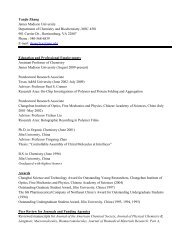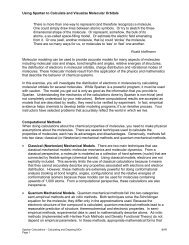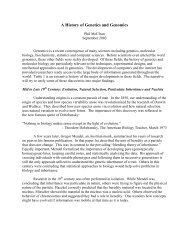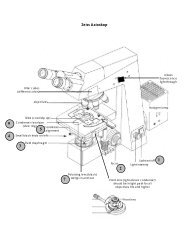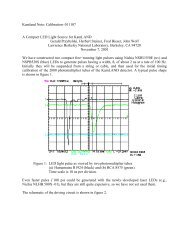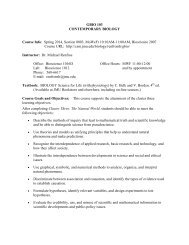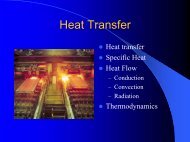2013 James Madison University Summer Undergraduate Research ...
2013 James Madison University Summer Undergraduate Research ...
2013 James Madison University Summer Undergraduate Research ...
Create successful ePaper yourself
Turn your PDF publications into a flip-book with our unique Google optimized e-Paper software.
Spectroscopic evidence of these salts affecting water is observed in the OH stretch region. Infrared Spectroscopyof the amide I and II bands of proteins can be used to study secondary structure and solvation. Differences inthese bands indicate that salts differentially influence protein structure and water-protein interactions. This is mostlikely due to specific ion binding. Complementary studies were performed in deuterium oxide. Changes in amideII shows salt induced protein structural changes. 2,2,2-Trifluoroethanol (TFE), known to desolvate the backbone ofhelical peptides, was used to further study solvation of RecA in attempts to identify vibrations associated withdesolvation.11:30 - 11:45Photoelectrochemical Performance of Tungsten Doped BiVO 4 FilmsMelissa Dutter, Dept. of Engineering, <strong>James</strong> <strong>Madison</strong> <strong>University</strong>Dr. S. Keith Holland, Dept. of Engineering, <strong>James</strong> <strong>Madison</strong> <strong>University</strong>Dr. David Lawrence, Dept. of Engineering, <strong>James</strong> <strong>Madison</strong> <strong>University</strong>Due to advances in fuel cell technologies, hydrogen gas and liquid fuels formed from it have emerged aspromising alternative fuel sources. Currently, most hydrogen is produced by methods that require methane gasas an input and release significant pollutant and greenhouse gases. However, hydrogen gas can be sustainablyproduced from water and sunlight via photoelectrolysis. Materials suitable for the production of hydrogen gasthrough photoelectrolysis have been the subject of research for over 40 years. Recently, bismuth vanadate,BiVO 4 , has shown promise as a photosensitive electrode material for photoelectrochemical (PEC) water splitting.In this study, thin-films of BiVO 4 were produced by ultrasonic spray pyrolysis of aqueous solutions containingbismuth nitrate and vanadium oxysulfate followed by calcining at 500ºC. N-type doping of the samples wasachieved by introducing tungsten-containing compounds to the precursor solutions: silicotungstic acid andammonium metatungstate. The effects of annealing the thin-film samples in a 3% H 2 atmosphere were alsoinvestigated. The PEC performances of the produced BiVO 4 photoanodes were tested using linear sweepvoltammetry under simulated solar illumination conditions. The materials were also analyzed using X-raydiffraction (XRD) and Scanning Electron Microscopy (SEM). Results indicated that H 2 annealing increased thephotocurrent density of the materials, while W doping hindered the PEC performance. Notable compositiondifferences between samples were observed from the XRD patterns and SEM studies, suggesting that thereduced PEC performance of W doped films was due to composition and morphology differences resulting fromthe addition of tungsten.11:45 - 12:00A Tale of Two Appalachian Highland Streams: Acid Mitigation Planning and ResultsLindsay House * , Dept. of Chemistry and Biochemistry, <strong>James</strong> <strong>Madison</strong> <strong>University</strong>Jacob Roodman*, Dept. of Chemistry and Biochemistry, <strong>James</strong> <strong>Madison</strong> <strong>University</strong>Daniel Downey, Dept. of Chemistry and Biochemistry, <strong>James</strong> <strong>Madison</strong> <strong>University</strong>Anthropogenic atmospheric acid is deposited in stream watersheds by rainfall, snow, and other precipitation.Acid precipitation is significantly more acidic than natural rain (pH < 5) due to the presence of nitric acid andsulfuric acid. High acidity stream water is detrimental to natural aquatic flora and fauna. The water chemistry of twostreams in southwest Virginia was assessed to determine optimum treatment plans to restore natural biota in eachstream. Water samples were obtained from North Fork Stony Creek, Giles County, Virginia and Little TumblingCreek, Smyth County, Virginia at various time intervals from 1988-<strong>2013</strong> and 2012-<strong>2013</strong>, respectively. In January2012, Little Tumbling Creek was treated with 60 tons of limestone (93% CaCO3). Samples were taken on aquarterly basis at locations in the Little Tumbling Creek watershed both upstream and downstream of the limingsite from 2012 to July <strong>2013</strong>. North Fork Stony Creek has not yet been treated with limestone, but sampleacquisition and analysis will assist in developing an acid mitigation plan for the stream. Samples were obtainedfrom North Fork Stony Creek in April and July <strong>2013</strong>. All samples were analyzed for pH, base metal cations (Ca 2+ ,Mg 2+ , Na + , K + ), major acid anions (Cl - , SO 4 2- , NO 3 - ), acid neutralizing capacity (ANC), and aluminum (Al T )concentrations. The average pH values of Little Tumbling Creek samples downstream and upstream from theliming site were 5.67 and 4.90, respectively. The average pH of North Fork Stony Creek samples was 5.39. Theresultant chemical data from both streams will supplement biological data for fish and aquatic insects inrespective acid mitigation projects.4
Oral Presentations Session IIIThursday, August 11:30 PM - 3:00 PMISAT/CS 159Dr. Costel Constantin, Presiding1:30 - 1:45Trophic State Index (TSI) of Several LakesJustin QuanCarlson’s Trophic State Index (TSI) is a classification system that measures the water quality of reservoirs, ameasure of whether the lake is clean and can support aquatic life. There are three variables that determine thetrophic state of the reservoirs: chlorophyll a, total phosphorus, and the Secchi disk method. Chlorophyll aconcentrations in the water samples are measured with a fluorometer from acetone extracts. The concentrationsof phosphorus in the water samples are measured by a colorimetric reagent after they are acid digested. TheSecchi disk method uses a circular disk that measures the depth of water transparency of a reservoir. We haveassessed several lakes this summer: Newman Lake, Lake Keokee, Glen Alton ponds and Lake Shenandoah.Descriptions of these lakes and water chemistry will be presented. The results will be reported to the US ForestService (USFS) and the Virginia Department of Games and Inland Fisheries (VDGIF) with recommendations on howto manage the reservoirs’ water quality.1:45 - 2:00A Global Property of Magnetohydrodynamic Accretion-Disk WindsPeter G. Clark*, Dept. of Physics and Astronomy, <strong>James</strong> <strong>Madison</strong> <strong>University</strong>Josh Mitri*, Dept. of Physics and Astronomy, <strong>James</strong> <strong>Madison</strong> <strong>University</strong>Keigo Fukumura, Dept. of Physics and Astronomy, <strong>James</strong> <strong>Madison</strong> <strong>University</strong>Astrophysical compact objects, such as black holes and neutron stars, are known to be surrounded by anoptically-thick geometrically-thin plasma structure called accretion disks. However, a good fraction of theaccreting plasma with too much energy and angular momentum is not gravitationally bound and fails to fall ontothe central engines. As a result, these plasma bounce back due to the outward centrifugal force and furtheraccelerated by magnetic forces via a large-scale magnetic field that is threaded through the accretion disk. In thecontext of magnetohydrodynamics we show by semi-analytic calculations that the magnetically-driven plasmamanifests itself as outflows whose physical and geometrical characteristics depend primarily on two parameters;energy flux ratio and angular momentum of the wind. Finally, observational significance of these wind solutions isdiscussed in an attempt to search for defining parameters to characterize a global condition of these ionizedwinds.2:00 - 2:15Characterization of Optically Active Rare Earth-Doped Nanoparticle Suspensions" to "Characterization ofFluorescent Rare Earth-Doped Nanoparticle SuspensionsJ. A. Wooten, Dept. of Chemistry and Biochemistry, <strong>James</strong> <strong>Madison</strong> <strong>University</strong>Fluorescent nanoparticles have applications on an extremely broad scope, from medical imaging to opticalmaterials and computing. For some applications, such as construction of optical materials, certain synthesispathways for these nanoparticles are more ideal than others. The purpose of this project is to analyze the processand effect of the aprotic solvent, N-methyl pyrrolidone, in the synthesis of Europium- and Terbium-dopedLanthanum (III) Fluoride nanocrystals containing acetylsalicylic acid ligands (complete nanoparticle). Analysis ofthe ligand was done using infrared spectroscopy and proton and C13 nuclear magnetic resonance spectroscopy,and showed no interaction between the ligand and the solvent. UV-visible spectroscopy, pH, photoluminescencetesting, transmission electron microscopy, and dynamic light scattering analysis was also conducted onnanoparticle suspensions. Photoluminescence testing of nanoparticles revealed reduction of the added europiumIII, and emissions indicative of europium II. Nanoparticles on the order of 20-40 nm were found.5
2:15 - 2:30Synthesis of chlororhenium tricarbonyl complexes of substituted bipyridine ligands for interfacial electrontransfer studiesJessica Simpson, Dept. of Chemistry and Biochemistry, <strong>James</strong> <strong>Madison</strong> <strong>University</strong>Debra Mohler*, Dept. of Chemistry and Biochemistry, <strong>James</strong> <strong>Madison</strong> <strong>University</strong>Tricarbonyl rhenium (I) complexes have been found to have very useful applications in chemi- orelectroluminescence, chemical and biological sensing, bioconjugation photoredox chemistry and asphosphorescent dopants for organic light emitting diodes due to their luminescent properties. Specifically, thiswork focuses on the importance of ultrafast electron transport systems, in order to understand the dynamicsbetween ET and molecular structure in ultrafast interfacial processes between metal or semiconductornanoparticles and molecular adsorbates. By attaching different substituents to the bipyridine ligands it isexpected to increase the ET rate by influencing the electronic coupling between the complex and asemiconductor. A molecule of chlorotricarbonylrhenium complexed with substituted bipyridine ligands has beensynthesized in order to measure their effects on ultrafast electron transport systems.2:30 - 2:45Purification and Structural Analysis of the anti HIV-1 protein, BST-2Kelly Du Pont*, Dept. of Chemistry and Biochemistry, <strong>James</strong> <strong>Madison</strong> <strong>University</strong>Christopher Berndsen, Dept. of Chemistry and Biochemistry, <strong>James</strong> <strong>Madison</strong> <strong>University</strong>BST-2/tetherin is an extracellular transmembrane protein that inhibits the release of the HIV-1 and other virusesfrom the cell surface in humans. BST-2 is a homo-dimer that forms a coiled-coil motif formed by the interweavingof the subunits, and contains three disulfide bonds, which connect the two subunits of the dimer. Recent work hassuggested that the BST-2 ectodomain is flexible or structurally dynamic. Substitution of a heterologous coiled-coilmotif resulted in a functional protein while extension of the ectodomain with non-coiled-coil sequences, resultedin a loss of function. This study focuses on the structure and function of BST-2 with the goal of connecting proteinstructure to cellular function. We have purified the ectodomain of human BST-2 to determine whether BST-2 iscompletely coiled-coiled, as suggested by the crystal structures, or whether there are flexible sections, assuggested by the functional experiments. We used circular dichroism, limited proteolysis, fluorescence and SAXSto analyze several structural aspects of the BST-2 ectodomain. The results from limited proteolysis and SAXSsuggested there are flexible regions within the structure of BST-2. We used SASSIE, a program to analyze SAXSdata, to determine whether or not BST-2 has one or more flexible regions, which may cause this irregular bend inthe structure. We found that BST-2 has flexible region only at one end of the protein. Future work will involvepurifying, characterizing and determining the structure of membrane bound protein of BST-2.2:45 - 3:00Thermal Decomposition of HydromagnesiteRafael Snell-Feikema, Harrisonburg High School / Massanutten Regional Governor’s SchoolNeil Mehta, Harrisonburg High School / Massanutten Regional Governor’s SchoolThomas DeVore, Dept. of Chemistry and Biochemistry, <strong>James</strong> <strong>Madison</strong> <strong>University</strong>Hydromagnesite is a basic carbonate of magnesium with a wide array of applications from antacids to ingredientsin perfume and it is an intermediate in the possible method for carbon sequestration starting with magnesiumoxide. Thus to study the decomposition of hydromagnesite, EGA-FTIR was used in conjunction with TGA tomonitor products and calculate kinetics data on three different samples of hydromagnesite. FTIR and x-raydiffraction were used to identify the initial substances and intermediates formed during the decomposition.Comparative studies in EGA-FTIR and TGA found differences in the decomposition mechanism and curvesdepending on the experimental conditions. Three steps were observed consistently in uncapped trials at lowheating rates but the decomposition mechanism becomes more complicated when the cell is closed or theheating rate is increased6
3:00 - 3:15Using Circular Dichroism to Investigate the Effects of Salts on Myoglobin UnfoldingJoseph C.M. Mosley*, Dept. of Public Health and Health Sciences, <strong>University</strong> of Michigan-FlintGina MacDonald, Ph.D., Dept. of Chemistry, <strong>James</strong> <strong>Madison</strong> <strong>University</strong>Previous studies of a DNA binding protein, RecA, from Escherichia coli, have shown inverse anionic Hofmeistereffects on protein stability and also showed the salts influence the aggregation state. Therefore the previousstudies have led to further studies of how anionic salts affect the structure and stability of a model protein thatdoes not aggregate at room temperature. Circular Dichroism is an optimal method to investigate how the effectsof various salts of the Hofmeister series alter the overall secondary structure and unfolding. CD studies onMyoglobin, an alpha helical protein, have shown consistent results with what would expect from the HofmeisterSeries. The salts studied include: NaCl, MgCl 2 , CaCl 2 , MgSO4, Na2SO4, NH 4 Cl, (NH 4 ) 2 SO 4 , and NaCIO 4. The saltsinvestigated do not have large influences on protein structure. However, some salts enhance the denaturationprocess whereas the others salts stabilize the structure of the protein. .3:15 - 3:30Utilizing Chloroform Post-treatment to Improve the Adhesion of Au Thin Films onto PMMA SubstrateKathleen Krist*, Dept. of Chemistry and Biochemistry, <strong>James</strong> <strong>Madison</strong> <strong>University</strong>Skylar White , Dept. of Chemistry and Biochemistry, <strong>James</strong> <strong>Madison</strong> <strong>University</strong>Brian Augustine, Dept. of Chemistry and Biochemistry, <strong>James</strong> <strong>Madison</strong> <strong>University</strong>Chris Hughes, Dept. of Physics and Astronomy, <strong>James</strong> <strong>Madison</strong> <strong>University</strong>The metallization of Au onto plastics is an important processing step in applications such as the aerospace andautomotive industries, the field of microelectronics, and the fabrication of microfluidic devices. While its corrosionresistance and excellent electrical and thermal conductivity make Au a useful choice, its inertness results in pooradhesion to polymer surfaces. Previous studies have indicated that exposing Poly(methyl methacrylate) (PMMA)sheets to chloroform vapor following Au deposition significantly improves adhesion. In this study, we utilizedelectron-beam evaporation to deposit 60 nm of Au onto 800 micron thick PMMA and exposed the samples tovapor released from chloroform heated on a hot plate set at 70°C. The force required to remove the Au thin filmswas determined by placing samples on a polisher spinning at 150 rpm and utilizing UV-VIS spectroscopy tomeasure the transmittance of 800 nm light through the films to quantify their removal as a function of appliedpolishing force. The Au thin films were also characterized using atomic force microscopy (AFM). AFM imagesdemonstrated a progressive roughening of the surface corresponding to an increase in applied force.Additionally, the AFM images support a model in which the chloroform treatment softens the PMMA surface,producing a softened layer that the polisher removes simultaneously with the Au thin filmPoster #1Poster Presentations SessionThursday, August 13:30 PM - 5:00 PMISAT/CS LobbyEffects of the Hofmeister Anions on the Interfacial Tension at the Hydrophobic/Aqueous InterfaceDiana Al Husseini*, Dept. of Chemistry and Biochemistry, <strong>James</strong> <strong>Madison</strong> <strong>University</strong>Natalie Trinh, Dept. of Chemistry and Biochemistry, <strong>James</strong> <strong>Madison</strong> <strong>University</strong>Yanjie Zhang, Dept. of Chemistry and Biochemistry, <strong>James</strong> <strong>Madison</strong> <strong>University</strong>Hofmeister series, first discovered in 1888 by Franz Hofmeister, is a set of ions in order of their ability to affectphysical properties in aqueous solutions. Many aqueous processes are found to follow the Hofmeister series suchas polymer aggregation, protein folding, protein stability, and colloid assembly. Although the Hofmeisterphenomena are general, the molecular level mechanisms of the Hofmeister series are still not well understood.Herein, we study the anion effects on the surface tension of water and the interfacial tension at the hydrophobic/aqueous interface by pendant drop method on an optical tensiometer in order to understand anion-interface7
interactions. So far, it has been observed that the surface tension of water increases linearly as salt concentrationsincrease. These studies will provide us with some valuable data that would help further the understanding ofmechanisms for the Hofmeister series.Poster #2Synthesis of Triple-Headed, Single-Tailed Amphiphiles with a Mesitylene CoreBrenden Wimbish; Dept. of Chemistry and Biochemistry, <strong>James</strong> <strong>Madison</strong> <strong>University</strong>David Bruno; Dept. of Chemistry, RIT/NTIDJohn Marafino; Dept. of Chemistry and Biochemistry, <strong>James</strong> <strong>Madison</strong> <strong>University</strong>Kevin Caran; Dept. of Chemistry and Biochemistry, <strong>James</strong> <strong>Madison</strong> <strong>University</strong>In this paper, we present the synthesis, colloidal and biological testing of a triple-headed, single-tailedamphiphiles. Amphiphiles are important because they are used in a variety of products including detergents,lotions and sanitizers. The compounds in this study are designed to help effectively kill bacteria. A major goal ofthe project is to develop an understanding of the relationship between amphiphile structure (number of heads,number of tails, tail length, etc.) and antibacterial activity. This summer, we have successfully prepared five newtriple-headed, single-tailed amphiphiles with tail lengths ranging from 8-16 carbons. Ongoing studies includebiological testing (minimum inhibitory concentration, synergy studies, etc.) and measurement of critical micelleconcentration (CMC) using conductivity, NMR and dye solubility. .Poster #3Trace Metals in BeerJon Clouston, Dept. of Chemistry and Biochemistry, <strong>James</strong> <strong>Madison</strong> <strong>University</strong>The levels of Ca, Mg, Fe, Co, and Cr were determined in eleven different beers by Flame Atomic AbsorptionSpectroscopy. FAAS is a simple, rapid and accurate means for analyzing such a diverse sample set. The sampleswere digested using concentrated trace metal grade HNO3 and H2O2 in closed PTFE vessels and applyingmicrowave energy under pressure. The analyzed concentrations for each beer were within the expected ranges.Poster #4The Study of Supporting Ligands for Ruthenium ComplexesNathan D. Crossland, Department of Chemistry, <strong>James</strong> <strong>Madison</strong> <strong>University</strong>Donna S. Amenta, Department of Chemistry, <strong>James</strong> <strong>Madison</strong> <strong>University</strong>John W. Gilje, Department of Chemistry, <strong>James</strong> <strong>Madison</strong> <strong>University</strong>The reaction of RuH(Cl)(CO)(PPh 3 ) 3 with N-pyrazolylpropanamide (N-ppa) and Ru(H) 2 (CO)(PPh 3 ) 3 with N-ppa werestudied under a variety of conditions with the objective of finding a root to substituted ruthenium hydridecomplexes. Microwave reactions in which the temperature, time, and solvent were varied were the first focus forthis study. The range of solvents used included tetrahydrofurane, toluene, methanol, dimethylformamide, andchloroform. The time ranged from 10 minutes to 5 hours and the temperature from 60°C to 190°C. While thestarting materials are individually stable under microwave conditions, mixtures of the reactants decomposed in allthe microwave experiments. NMR scale studies of RuH(Cl)(CO)(PPh 3 ) 3 with N-ppa at ambient temperature in d-chloroform indicated displacement of a single triphenylphosphine and the formation of RuH(Cl)(CO)(PPh 3 ) 2 (Nppa).Similarly, NMR scale reactions of RuH(Cl)(CO)(PPh 3 ) 3 with bis(diphenylphosphino)propane oxide (dPPPO)were also studied. Supporting data will be presented.Poster #5Do Donor Ligands Displace N-pyrazolylpropanamide (N-ppa) from RuCl 2 (PPh 3 ) 2 (N-ppa)? Solution Behaviorof RuCl 2 (PPh 3 ) 2 (N-ppa) and RuCl 2 (PPh 3 ) 3 with Nitriles and DimethylformamideSantina Cruz, Department of Chemistry and Biochemistry, <strong>James</strong> <strong>Madison</strong> <strong>University</strong>Donna S. Amenta, Department of Chemistry and Biochemistry, <strong>James</strong> <strong>Madison</strong> <strong>University</strong>John W. Gilje, Department of Chemistry and Biochemistry, <strong>James</strong> <strong>Madison</strong> <strong>University</strong>The solution behavior of RuCl 2 (PPh 3 ) 2 (N-ppa) and RuCl 2 (PPh 3 ) 3 with nitriles and dimethylformamide has beeninvestigated. Initially, the reaction of RuCl 2 (PPh 3 ) 3 with N-pyrazolylpropanamide was optimized formingRuCl 2 (PPh 3 ) 2 (N-ppa) in about 75% yield. In an effort to obtain NMR spectra of this compound a variety of solventswere investigated. RuCl 2 (PPh 3 ) 2 (N-ppa) is insoluble in non-polar solvents, but dissolves in some polar solvents.8
However, in these cases the N-ppa appears to be displaced. Thus, RuCl 2 (PPh 3 ) 2 (N-ppa) in excess of CD 3 CNproduced NMR spectra that are analogous to spectra obtained on solutions of RuCl 2 (PPh 3 ) 3 in CD 3 CN . Thisindicates that RuCl 2 (PPh 3 ) 2 (NCCD 3 ) 2 , the deuterated analog of reported product of the reaction of RuCl 2 (PPh 3 ) 3with CH 3 CN, is formed in the RuCl 2 (PPh 3 ) 2 (N-ppa) reaction. As a part of these studies the crystal structure ofRuCl 2 (PPh 3 ) 2 (NCC 6 H 5 ) 2 was determined. In many of these reactions, NMR spectra indicate the formation of aspecies we postulate to be an unsymmetrical chloride bridged binuclear ruthenium species. Attempts areunderway to prepare larger quantities of these. Closely related chemistry appears to occur with HC(O)N(CH 3 ) 2 .Poster #6Determining the composition of low temperature distilled hydrogen deuteride with gas chromatographyDavid D’Amico,* Dept. of Chemistry and Biochemistry, <strong>James</strong> <strong>Madison</strong> <strong>University</strong>Donna S. AmentaDept. of Chemistry and Biochemistry, <strong>James</strong> <strong>Madison</strong> <strong>University</strong>John W. Gilje, Dept. of Chemistry and Biochemistry, <strong>James</strong> <strong>Madison</strong> <strong>University</strong>The coordination of substituted N-pyrazolylpropanamide ligands to various metallic ions was carried out to obtaincrystalline solids. The new ligands; N-3 methyl pyrazolylpropanamide (L1), N-pyrazolyl,N,N dimethylpropanamide (L2), N-pyrazolyl-2-methyl propanamide (L3), and N-pyrazolyl-N-isopropyl propanamide (L4) weresynthesized then allowed to react with MnCl 2 4H 2 O, NiCl 2 H 2 O, and Ce(NO 3 ) 3 6H 2 O. The ligands were alsoallowed to react with Cl 2 Ru(PPh 3 ) 3 on an NMR scale in various deuterated solvents. In many cases well definedcrystals were formed and will be sent for crystal x-ray analysisPoster #7Determining the composition of low temperature distilled hydrogen deuteride with gas chromatographyJ. Devilbiss*, Dept. of Physics and Astronomy, <strong>James</strong> <strong>Madison</strong> <strong>University</strong>S. Whisnant, Dept. of Physics and Astronomy, <strong>James</strong> <strong>Madison</strong> <strong>University</strong>J. Mueller, TUNL, Duke <strong>University</strong>L. Myers, TUNL, Duke <strong>University</strong>M. Ahmed, TUNL, Duke <strong>University</strong>H. Weller, TUNL, Duke <strong>University</strong>Photonuclear neutron emission was generated by having linearly polarized gamma rays incident on a natural Pbtarget. Beam energies were 11, 12, 13, 14, 15 and 15.5 MeV. 16 Scintillating detectors were placed at azimuthalangles of 55, 90, and 125 degrees every 90 polar degrees. The remaining four detectors were placed at azimuthalangles of 72 and 107 degrees above the beam and to beam right. The ratio of neutron yield was taken forneutrons in plane of photon polarization and out of the place. Results will be discussed.Poster #8Thermoelectric Properties of Manganese (IV) Oxide Particles as a function of Electrical ResistanceMorgan Hedden * , Dept. of Physics and Astronomy, <strong>James</strong> <strong>Madison</strong> <strong>University</strong>Nicholas Francis *, Dept. of Physics and Astronomy, <strong>James</strong> <strong>Madison</strong> <strong>University</strong>Costel Constantin*, Dept. of Physics and Astronomy, <strong>James</strong> <strong>Madison</strong> <strong>University</strong>Due to the ever-increasing energy demand and growing global concern over the environmental impact of carbondioxide emissions, there is an urging need to seek solutions to transit from fossil fuels to sustainable energy. Only30% of the energy used every day is converted into useful work and the remaining 70% is wasted as dissipatedheat during energy conversion, transportation and storage. This giant loss is itself a source of recyclable energythat can be renewed into useful energy. Thermoelectric (TE) materials show great promise for converting wasteheat energy into electricity. TE systems have many unique advantages such as silent operation, time reliability, anddimensional scalability. Most recently, researchers Song et al. [1] found that MnO 2 nanoparticles show a giantSeebeck coefficient of S = 20 mV/K, which is 100 times higher than bismuth telluride, one of the best TE materials.Song et al.[1] concluded the paper claiming that the giant S is related to the surface density of the electronic states(DOS). However, no figure of merit measurements (ZT) have been reported so far. In this project, we presentpreliminary results of ZT, Seebeck coefficient and thermal and electrical conductivities as a function of particleelectrical resistance in the range of 10-80 Ω for particle sizes in the range of 5 nm-150 µm. ZT values rangedbetween 0.12-0.18. Preliminary results show that all properties measured except ZT depend on the range ofelectrical resistances tested. However, the smallest samples show the greatest promise for further increasing ZT.9
Poster #9A Semantic Field Approach to Short- and Long-Term Vocabulary Recall In American Sign LanguageKelsey Gilchriest, Department of Political Science, <strong>James</strong> <strong>Madison</strong> <strong>University</strong>Matthew Mitchell, Department of Music, <strong>University</strong> of Michigan – FlintJudy Bradley, Ed.S., Dept. of Chemistry and Biochemistry, <strong>James</strong> <strong>Madison</strong> <strong>University</strong><strong>Research</strong> with learners of spoken second languages suggests that context plays a role in learning new vocabulary.The role of context (i.e., semantic field) in recall of new sign vocabulary has not been fully explored. Non-signers’memory for semantic field-specific versus non-field-specific signs was tested, using 10 lexical items related tochemistry and 10 unrelated to chemistry. A test of short-term and long-term retention was developed to assesssign vocabulary learning in non-signers. Participants were 27 students from the ages of 18 to 28 who wereparticipating in a Chemistry research program. Results suggest that there is no significant difference betweenstudents’ retention of chemistry- and non-chemistry-related signs, but students remembered significantly moresigns in the long-term retention condition regardless of semantic field.Poster #10Photoelectochemical performance of BiVO 4 on ITO and FTOJoel Groetsema, Dept. of Engineering, <strong>James</strong> <strong>Madison</strong> <strong>University</strong>Dr. S. Keith Holland, Dept. of Engineering, <strong>James</strong> <strong>Madison</strong> <strong>University</strong>Dr. David Lawrence, Dept. of Integrated Science and Technology, <strong>James</strong> <strong>Madison</strong> <strong>University</strong>Materials suitable for the production of hydrogen gas, a potential alternative fuel source, throughphotoelectrolysis have been the subject of research for over 40 years. Recently, bismuth vanadate, BiVO 4 , hasshown promise as a photoanode material for photoelectrochemical (PEC) water splitting. BiVO 4 thin films weredeposited on different conducting substrates to study the effect of the substrate selection on the PECperformance of photoanodes. An aqueous solution of bismuth nitrate and vanadium oxysulfate was deposited viaultrasonic spray pyrolysis on glass slides coated with either indium-doped tin oxide (ITO) or fluorine-doped tinoxide (FTO). The resulting BiVO 4 films were then calcined, annealed in a 3% H 2 atmosphere, and prepared asphotoanodes. The PEC performance of the different photoanodes under simulated solar illumination wasevaluated using linear sweep voltammetry. Scanning electron microscopy (SEM) was used to analyze themorphological differences between samples deposited on the ITO and FTO substrates. Additionally, the effectsof tungsten doping as well as air and hydrogen annealing on the BiVO 4 deposited on FTO coated slides wereinvestigated. Tungsten doping was achieved by including either silicotungstic acid (STA) or ammoniummetatungstate (AMT) in the aqueous precursor. Results from the PEC performance tests showed that the BiVO 4films deposited on FTO exhibited greater photocurrents than those deposited on ITO. This could be due to thedifferent morphologies of the films between the two glass coatings, as observed using the SEM. Additionally, itcan be noted that the tungsten doping did not enhance the PEC performance of the films. This could again beexplained by morphological differences, or, as x-ray diffraction (XRD) analysis has indicated, may be from theinclusion of different material phases within the filmsPoster #11Formulation of Metallography Lab Module for Material Characterization LabRobert Hurlbrink, Department of Physics and Astronomy, <strong>James</strong> <strong>Madison</strong> <strong>University</strong>Dr. Kyle Gipson, Department of Engineering, <strong>James</strong> <strong>Madison</strong> <strong>University</strong>In a growingly technical world, Metallography, or the study of the physical structure of metals, is becomingincreasingly relevant as metals are being used in new applications each year. The goal of my project was todevelop a Metallography lab module with the Center for Material Science here at <strong>James</strong> <strong>Madison</strong> <strong>University</strong>,intended for a material characterization lab. The module includes three labs: Preparation of MetallographicSamples using a Grinder and Polisher, Determination of Grain Size using an Inverted Microscope, andDetermination of Chemical Composition using an XRF Analyzer. Students completing this module will beintroduced to several pieces of analytical equipment used heavily in the metal industry today, as well as givestudents a better idea of metals and their properties.10
tri(dimethylaminomethyl)phenol (1) was dissolved in toluene with a catalytic amount of the phase transfer catalysttetrabutylammonium bromide. Aqueous potassium hydroxide was slowly added to the solution under reflux at 80°C, followed by the addition of a 1-bromoalkane, which resulted in an aryl ether product. Exhaustive methylationwith bromomethane in ethanol yields the triscationic amphiphile. Synthetic progress and ongoing work will bepresented.Poster #18Identification and Quantitation of Metals in Beer by Titrimetry and Spectroscopy.Adele Pierre*, National Technical Institute for the Deaf, Rochester Institute of TechnologyJon Clouston, Dept. of Chemistry and Biochemistry, <strong>James</strong> <strong>Madison</strong> <strong>University</strong>Richard Foust, Dept. of Chemistry and Biochemistry, <strong>James</strong> <strong>Madison</strong> <strong>University</strong>Christine Hughey, Dept. of Chemistry and Biochemistry, <strong>James</strong> <strong>Madison</strong> <strong>University</strong>Metals enter beer through a variety of routes, including the raw ingredients (water, grain, hops and yeast), thebrewing vessels and the storage containers (cans, kegs and casks). Here we analyzed the metal content of 11different beers. A compleximetric titration with EDTA and atomic absorption spectroscopy (AAS) was used toquantify calcium and magnesium, while ICP-MS was used to quantify 20 different trace metals. The Ca/Mg resultsobtained by titration and AAS varied greatly. For instance, the Mg concentration determined by AAS was 82%higher and 68% lower in Stella Artois and Blue Moon, respectively, compared to titration concentrations. Overall,AAS data produced lower concentration in five of the 11 beers. On the other hand, the calcium concentrationsdetermined by AAS were consistently lower than the titrimetry concentrations. The large discrepancy between thetitration and AAS data is likely due to the incomplete precipitation of calcium by ammonium oxalate prior totitration. However, more work is needed to support this hypothesis. ICP MS revealed that Al (Avg = 145 ppb) wasthe most abundant metal in the beers, followed by Mn (79 ppb), Zn (46 ppb), Ni (19 ppb) and Cu (17 ppb). Notsurprisingly, the beer with the highest Al concentration (Coors Banquet) was stored in an aluminum can. Futurework will focus of the integration of ICP MS data with ESI LC/MS data in the differential analysis of beers.Poster #19Limestone Analysis for ArcheologyJacob Roodman * , Dept. of Chemistry and Biochemistry, <strong>James</strong> <strong>Madison</strong> <strong>University</strong>Daniel Downey , Dept. of Chemistry and Biochemistry, <strong>James</strong> <strong>Madison</strong> <strong>University</strong>The Shenandoah Valley contains vast amounts of limestone bedrock. Historically, this limestone has been minedand used in the construction of numerous structures around Virginia. Limestone varies in its elementalcomposition of calcium, magnesium, and various trace elements based on the conditions present at the time ofrock formation. This study focuses on developing an analytical technique to match the limestone used in theconstruction of historic structures to the quarry location the limestone was mined from based on variations in theelemental composition of the limestone. Prior to analysis, the solid rock limestone samples must be digested intosolution. Traditional digestion methods are time consuming and tedious, so a new digestion method wasdeveloped using a Microwave Accelerated Reaction System (MARS). Samples were analyzed for calcium andmagnesium concentrations using Atomic Absorption Spectrometry. Inductively Coupled-Plasma MassSpectrometry (ICP-MS) was used to determine trace elements present in the limestone samples.Poster #20Water Chemistry Changes in the South Fork of the Shenandoah River and Smith Creek followingDownpoursDianté Ryals * , Dept. of Chemistry and Biochemistry, <strong>James</strong> <strong>Madison</strong> <strong>University</strong>Jon Clouston*, Dept. of Chemistry and Biochemistry, <strong>James</strong> <strong>Madison</strong> <strong>University</strong>Robbie Hurlbrink*, Dept. of Chemistry and Biochemistry, <strong>James</strong> <strong>Madison</strong> <strong>University</strong>Ziza Machado*, Dept. of Chemistry and Biochemistry, <strong>James</strong> <strong>Madison</strong> <strong>University</strong><strong>James</strong> Wooten*, Dept. of Chemistry and Biochemistry, <strong>James</strong> <strong>Madison</strong> <strong>University</strong>Richard Foust, Dept. of Chemistry and Biochemistry, <strong>James</strong> <strong>Madison</strong> <strong>University</strong>Water chemistry of the South Fork of the Shenandoah River was compared with the water chemistry of SmithCreek. Water samples were collected at five sites on the South Fork of Shenandoah River and at 3 sites on SmithCreek over the course of four sampling trips (June 12, June 25, July 15, July 19). Field measurements included13
pH, dissolved oxygen, conductivity, turbidity, and water temperature. Four water samples per site were collectedin polyethylene bottles for further analysis in the laboratory. The four samples returned to the lab were: (1) nonfiltered,non-acidified, (2) non filtered, acid stabilized with H₂SO₄, (3) non-filtered, acid stabilized with HNO₃, and(4) field filtered (0.45 micron), acid-stabilized with HNO₃. These samples were analyzed for dissolved Ca, dissolvedMg and alkalinity, and reserved for total metals analysis and Chemical Oxygen Demand measurements. Theresults are interpreted based on water volume, flow rates and the local geology.Poster #21Synthesis and Characterization of a Typical Nicotinic Acetylcholine Receptor LigandMichael Schmitz;* Dept. of Biology, Gallaudet <strong>University</strong>Bernardo Toledo; Dept. of Chemistry, Gallaudet <strong>University</strong>Adebowale Ogunjirin; Dept. of Biology, Gallaudet <strong>University</strong>Compounds that bind to nicotinic acetylcholine receptor subtypes are important to medicinal chemists. Thesecompounds hold potential as pharmacological tool and for the treatment of many diseases. Majority of thesecompounds contain an ether link usually formed via Mitsunobu reaction, which therefore require difficultpurification process. Our goal is to show a rational method for discovery, synthesis and isolation and identificationof typical nAChR ligand in laboratory.Poster #22The synthesis and characterization of thienyl phosphine derivatives for polymerizable metal complexesJessica L. Shott*, Dept. of Chemistry and Biochemistry, <strong>James</strong> <strong>Madison</strong> <strong>University</strong>Brycelyn M. Boardman, Dept. of Chemistry and Biochemistry, <strong>James</strong> <strong>Madison</strong> <strong>University</strong>The synthesis of brominated and non-brominated thiophene and bithiophene phosphine ligands were performedby the reaction of thiophene derivatives with n-butyllithium followed by the addition ofchlorodiisopropylphosphine. The reactions of 2-bromothiophene and 2,5-dibromo-thiophene under theseconditions produced 2-diisopropylphosphinothiophene (1) and 2-diisopropylphosphino-5-bromothiophene (2)respectively. Similarly, 2,2’-bithiophene and 5,5’-dibromo-(2,2’)-bithiophene yielded 5-diisopropylphosphino-2,2’-bithiophene (3) and 5-bromo-5’-diisopropylphosphino-2,2’-bithiophene (4) respectively. Compounds 1, 2, 3, and4 were then allowed to react with either cobalt carbonyl or a mixture of cobalt carbonyl and triethylphosphine toform metal complexes comprised of polymerizable thienylphosphine ligands covalently bound to the metalcenter. The intermediates and final products were characterized using 1 H and 31 P NMR, GC-MS, and FT-IR. Theresulting metal complexes were a deep blue or green. Downfield shifts in the 31 P spectra indicated cobaltphosphorus bond formation, however the final structures of the complexes are still being investigated.Poster #23Aalborg GFC17 Control MethodsJeffrey Storey*, Dept. of Physics and Astronomy, <strong>James</strong> <strong>Madison</strong> <strong>University</strong>C. Steven Whisnant, Dept. of Physics and Astronomy, <strong>James</strong> <strong>Madison</strong> <strong>University</strong>The Hydrogen Deuterium Distillery facility is used for the distillation of hydro- gen deuteride (HD), which is aprocess that produces HD gas at a high level of purity. The Aalborg GFC17 Mass Flow Controller is thecomponent in this machine that con- trols the production of HD gas. The Aalborg GFC17 Mass Flow Controller is asensitive gas flow control and monitoring device that offers both hardware and software control. The higher thefreedom of control of this device, the easier it is use and monitor the flow of HD, log the data accumulated overtime and keep track of production levels. In order to achieve this the hydrogen deuteride distillation facilityrequired a new set of cables, which were constructed in order to achieve this functionality.Poster #24Phase Behaviors of PEO-PPO-PEO Triblock Copolymer in the Presence of Salts and AlcoholsColin Wallace*, Dept. of Chemistry and Biochemistry, <strong>James</strong> <strong>Madison</strong> <strong>University</strong>Yanjie Zhang, Dept. of Chemistry and Biochemistry, <strong>James</strong> <strong>Madison</strong> <strong>University</strong>The phase behaviors of a poly(ethylene oxide)-b-poly-(ethylene oxide) (PEO-PPO-PEO) triblock copolymer in thepresence of salts and alcohols were investigated by using an Optimelt automated melting point system. Insolutions with low concentrations of alcohols, the polymer underwent a two-step phase transition while at high14
concentrations of alcohols there was a one-step phase transition. Introduction of salts into the methanol-polymermixture did not influence the effects of methanol on the phase behaviors of PEO-PPO-PEO significantly. On theother hand, addition of methanol into salt-polymer mixture enhanced the effects of salts on PEO-PPO-PEO phasebehaviors. The mechanisms of interactions between the anion, methanol, and the polymer that affect the phasebehaviors of the polymer were discussed.Poster #25Determining the composition of low temperature distilled hydrogen deuteride with gas chromatographyColleen Wallace*, Dept. of Physics and Astronomy, <strong>James</strong> <strong>Madison</strong> <strong>University</strong>C. Steven Whisnant, Dept. of Physics and Astronomy, <strong>James</strong> <strong>Madison</strong> <strong>University</strong>Low temperature distillation and purification of hydrogen deuteride (HD) gas is being done at <strong>James</strong> <strong>Madison</strong><strong>University</strong> to prepare frozen-spin HD targets for use in photonuclear experiments at Jefferson Lab. Before the gasis declared good enough for use in experiments, it is tested using gas chromatography. Gas chromatography isnecessary to accurately determine the purity of the gas we distill, which is near the 99.9th percentile. Despite thehigh level of purity of the samples, trace amounts of impurities remain; specifically ortho-H 2 , para-H 2 , and D 2 . Thegas chromatograph itself is a Varian CP-3800, capable of determining the composition of the gas by creating aVoltage vs. Retention Time graph. It does this via a thermal conductivity detector (TCD) which compares thedifferences in voltages between the carrier gas (neon) and a sample gas; in this case, the distilled hydrogen. Theareas are then corrected for their relative thermal conductivities to yield the concentrations.Poster #26Ultrahigh Temperatures Recorded in Lower Crustal Xenoliths from the Shenandoah Valley, VAJacob Helsley*, Dept. of Geology and Environmental Science, <strong>James</strong> <strong>Madison</strong> <strong>University</strong>Elizabeth A. Johnson, Dept. of Geology and Environmental Science, <strong>James</strong> <strong>Madison</strong> <strong>University</strong>Ben Schwartz, Department of Geography, Texas State <strong>University</strong> - San MarcosHarvey E. Belkin, United States Geological Survey, RestonIn this study we use petrographic observations and Zr-in-rutile thermometry of xenoliths within Late Jurassic dikesto constrain the phase assemblage and temperature of the lower crust under Eastern North America. Sampleswere collected from three locations in western VA: 5 Springs, Vulcan Quarry, and Arey Farm. Mineral phases wereidentified using EDS analyses at JMU and the USGS and the Raman microprobe in the Mineral SpectroscopyLaboratory at Virginia Tech. Metasedimentary gneisses from 5 Springs and Arey Farm contain quartz + alkalifeldspar + garnet + rutile + sillimanite + zircon ± apatite ± graphite with retrograde chlorite, ilmenite, monazite,sulfides, and barite. A metasedimentary xenolith at Vulcan Quarry consists of feldspar + quartz + biotite +graphite + zircon + rutile with minor barite. Igneous xenoliths from Vulcan Quarry contain feldspar + pyroxene +apatite + magnetite + Nb oxide. Textures consistent with ultrahigh-temperature (UHT) metamorphism includingexsolved rutile needles in garnet and quartz inclusions surrounded by radial fractures within garnet were found inthe metasedimentary gneiss xenoliths. The JEOL Superprobe 8900R electron microprobe at the USGS was usedto quantify Zr concentrations in rutile. Due to their small widths (< 5 µm), rutile needles in garnet could not beanalyzed. Instead, compositions of rutile crystals within the groundmass as well as larger rutile inclusions withingarnet and quartz were measured. Preliminary comparison of the mineral assemblage of the gneissic xenolithswith the pseudosection diagram of Ague (<strong>2013</strong>) constrains maximum P > 8.5 kbar. The Zr-in-rutilegeothermometer of Tomkins (2007) was used to calculate temperatures using P = 10 kbar. The Vulcan Quarrybiotite gneiss xenolith records temperatures between 655 - 784°C. The Arey Farm and 5 Springs xenoliths havecalculated temperature ranges of 718 – 984°C and 637- 912°C, respectively, that extend into the UHT field. UHThave only been reported in one other location in the Eastern US (Ague <strong>2013</strong>). The metasedimentary xenolithshave Grenvillian detrital zircon ages (Rossi <strong>2013</strong>) with no evidence for growth in subsequent orogenic events. TheUHT recorded in the xenoliths may have been produced by prolonged (>800 Ma) deep burial and partial meltingof the lower crust.15
Poster #27U-Pb geochronology of Grenvillian and Late Jurassic lower crustal xenoliths in the Shenandoah Valley, VA.Nicholas Rossi*, Dept. of Geology and Environmental Science, <strong>James</strong> <strong>Madison</strong> <strong>University</strong>Elizabeth A. Johnson, Dept. of Geology and Environmental Science, <strong>James</strong> <strong>Madison</strong> <strong>University</strong>Benjamin Schwartz, Dept. of Geography, Texas State <strong>University</strong> at San MarcosLate Jurassic (~150 Ma) and Eocene (~48 Ma) volcanics found in the Shenandoah Valley, VA, containmetasedimentary and igneous lower crustal xenoliths. The analysis of these xenoliths allows for vertical profilingof the crust and mantle and provides important constraints on the structure and geological history of the EasternNorth American Margin (ENAM). U-Pb ages were determined for xenoliths from three locations at the LaserChronCenter at the <strong>University</strong> of Arizona. Xenoliths were cut from dike material, and zircon crystals were separated andhand selected for analysis using a laser ablation multi-collector inductively coupled plasma mass spectrometer(LA-MC-ICPMS). At two locations, Arey Farm and 5 Springs, only metasedimentary garnet- and sillimanite-bearinggneissic xenoliths were found. The wide age ranges of 883-1161 Ma (5 Springs) and 938-1258 Ma (Arey Farm)from these xenoliths strongly suggest detrital populations of Grenville age and further detrital age dating isneeded. At the third location, Vulcan Quarry, two distinct age populations were found: 151.7±1.8 Ma (MSWD =0.50) and a less abundant population with ages ranging from ~950-1215 Ma. The late Jurassic igneous xenolithscorrespond in age with a local pulse of magmatism at ~150 Ma. The age of the Vulcan Quarry dike is unknown,but we hypothesize that the igneous xenoliths are cogenetically related to this post-rifting magmatism. Thezircons from metasedimentary xenoliths show no discernible rims of post-Grenville age. This implies there has notbeen resetting by subsequent orogenic events in the Appalachians, even in the location which also contains ~150Ma xenoliths. The gneissic xenoliths at 5 Springs and Arey Farm record ultrahigh temperatures (max T > 900°C;Helsley <strong>2013</strong>). Future work to relate the Grenvillian xenoliths to known Grenvillian basement rocks exposed to theeast in the Blue Ridge will provide regional context of the composition and age of the lower crust in ENAM.9:00 - 9:15Oral Presentations Session IVFriday, August 29:00 AM - 10:15 AMISAT/CS 159Dr. Kevin Caran, PresidingThe Design and Fabrication of Microfluidic Devices for Neuron AnalysisThomas Hoke,* Dept. of Physics and Astronomy, <strong>James</strong> <strong>Madison</strong> <strong>University</strong>Kurt Clauss,* Dept. of Physics and Astronomy, <strong>James</strong> <strong>Madison</strong> <strong>University</strong>Brian Augustine, Dept. of Chemistry and Biochemistry, <strong>James</strong> <strong>Madison</strong> <strong>University</strong>Chris Hughes, Dept. of Physics and Astronomy, <strong>James</strong> <strong>Madison</strong> <strong>University</strong>The purpose of our research is to model and construct microfluidic devices to be used to study neurons. Thedesigns were created to study specific characteristics of the neurons, which were made on AutoCad. The top layerof the device is made out of PDMS (polydimethylsiloxane) using soft lithography. This layer consists of a series ofchambers and channels for the soma and axons. A second layer is added to the device incorporating a PMMAmembrane. The membrane is designed for the soma to sit on the surface and allow the dendrites to grow throughthe membrane. Channels are embossed onto the bottom side of the PMMA layer to allow the axons to growthrough. This membrane is fabricated using a monomer solution consisting of PMMA in MMA, BME, sIlica beadsor Ni nanowires. This solution is micropippettted into a hole in a 200micron PMMA slide and isphotopolymerized. This membrane is then etched(in HF for silica or Aqua Regia for Ni) to make a porous networkwhich allows the dendrites to grow through. A third layer of PDMS is added to the bottom of the device to closethe system. These devices can be used to study preferential neural pathways, spinal cord injuries and the effectson drugs on axon movement.16
9:15 - 9:30Structural analysis of the Ig59 domain of obscurinTracy Caldwell, Dept. of Chemistry and Biochemistry, <strong>James</strong> <strong>Madison</strong> <strong>University</strong>Nate Wright, Dept. of Chemistry and Biochemistry, <strong>James</strong> <strong>Madison</strong> <strong>University</strong>Obscurin (800-900 kDa) is a giant muscle protein vital to muscle cell maintenance and organization. Mutations toobscurin and surrounding proteins are linked to cardiomyopathies and muscular dystrophies. A mutation in Ig58of obscurin (Arg4344Gln) was found to be linked to hypertrophic cardiomyopathy (HCM). This mutation ablatesobscurin binding to titin at the binding site of Ig58/59 to ZIg9/10. In an attempt to fully characterize both the wildtypeand mutant protein structure, here we describe initial NMR-based efforts towards Ig58/59 structuredetermination9:30 - 9:45Thermoelectric Power Generation in an Isolated CompartmentHarkirat S. Mann,* Dept. of Physics and Astronomy, <strong>James</strong> <strong>Madison</strong> <strong>University</strong>Yosyp Schwab,* Dept. of Physics and Astronomy, <strong>James</strong> <strong>Madison</strong> <strong>University</strong>Brian N. Lang,* Dept. of Physics and Astronomy, <strong>James</strong> <strong>Madison</strong> <strong>University</strong>Andrew E. Masters, Custom Thermoelectric, Bishopville, MDGiovanna Scarel, Dept. of Physics and Astronomy, <strong>James</strong> <strong>Madison</strong> <strong>University</strong>Recently thermoelectrics have been closely examined in order to determine whether future research isworthwhile. On one side of the argument, critics describe future research as a worthless endeavor; whileproponents argue for a focus on creating better materials within these devices to produce better efficiencies. Thefocus of this project is to reinvigorate interest in these devices by exploring various extrinsic factors; which couldpossibly lead to a better understanding of the fundamental physics involved, as well as better efficiencies withthese devices.9:45 - 10:00Specific Anion Effects on Partition Coefficient of Caffeine between Organic and Aqueous PhasesBradley Rogers*, Dept. of Chemistry and Biochemistry, <strong>James</strong> <strong>Madison</strong> <strong>University</strong>Yanjie Zhang, Dept. of Chemistry and Biochemistry, <strong>James</strong> <strong>Madison</strong> <strong>University</strong>The Hofmeister series, discovered in 1888, originally ranked ions in correspondence to their relative effects onprotein solubility in aqueous solution. The Hofmeister series of ions has proven to hold true for a variety ofphysical behaviors in aqueous solution including protein denaturation, micelle formation, as well as surfacetension. Despite significant research efforts confirming the ranking of the series, the mechanisms that explain theobserved effects are not well understood. In this presentation, we investigate the specific anion effects on thepartition coefficient of caffeine between organic and aqueous phases. The mechanisms for how ions interact withcaffeine and further affect its partition will be discussed. The mechanisms for the modulation of partitioncoefficient of caffeine by anions may be applied to explain the Hofmeister effects on other aqueous solutionbehaviors.10:00 - 10:15Structural and Functional Analysis of Disease Causing Mutations in the M10 domain of TitinMichael Rudloff,* Dept. of Chemistry and Biochemistry, <strong>James</strong> <strong>Madison</strong> <strong>University</strong>Nate Wright, Dept. of Chemistry and Biochemistry, <strong>James</strong> <strong>Madison</strong> <strong>University</strong>Titin (3-4mD) is the largest monomeric protein found in humans and is crucial for the overall structural stability andfunction of muscle tissues. Dubbed the “molecular ruler”, titin sets the length of the sarcomere while ensuring thestructure is organized. While titin has many binding regions along its length, the extreme C-terminal domain (M10)plays an important role by binding to the extreme N-terminal domain (Ig1) of the giant muscle protein obscurin.This complex is critical for maintaining structure at the M-band of the sarcomere. Mutations in the M10 domain oftitin have been linked to cases of limb girdle muscular dystrophy 2J (LGMD2J), most likely due to an ablation ofM10-Ig1 binding. This summer, wild type M10 and all known human M10 mutations were expressed in bacteriaand purified. Initial structure characterization using Circular Dichroism indicate that while the wild-type domain ispredominantly beta sheet, most mutations are only partially folded. Isothermal Titration Calorimetry studies17
demonstrate that unfolded or misfolded mutants do not bind to Ig1, however one mutant binds to Ig1 with asimilar affinity to wild-type. Protein NMR spectroscopy confirms these findings, and will be used in future studiesto probe in more detail why one mutant M10 domain behaves similarly to wild-type in biochemical assays, yetcauses muscular dystrophy.Oral Presentations Session VFriday, August 210:30 AM - 12:00 PMISAT/CS 159Dr. Giovanna Scarel, Presiding10:30 - 10:45Plastic and Elastic Deformations of Foam Bubbles Driven by Oscillatory CompressionChristine O’Dea,* Dept. of Physics and Astronomy, <strong>James</strong> <strong>Madison</strong> <strong>University</strong>Klebert Feitosa, Dept. of Physics and Astronomy, <strong>James</strong> <strong>Madison</strong> <strong>University</strong>Fluidization of two-dimensional (2D) foam is characterized by rearrangement events known as T1-events whereclusters of four bubbles suddenly switch neighbors. This research focus on the rearrangement of the packingstructure of a bubble raft confined between a stationary and an oscillating boundary. Images of the bubble raftwere taken with a high speed camera as the raft was subject to different kinds of oscillatory conditions. We findthat T1–events are depend on the amplitude of the oscillation where smaller oscillations cause fewer reversiblerearrangements (elastic deformations), whereas large oscillations cause many non-reversible rearrangements(plastic deformations). We also report on preliminary measures of time and spatial correlation of T1-events.10:45 - 11:00Development of a solid phase microextraction (SPME) GC/MS method for the characterization of volatilecompounds in beer.Daniel Moon*, Dept. of Chemistry and Biochemistry, <strong>James</strong> <strong>Madison</strong> <strong>University</strong>Adele Pierre, National Technical Institute for the Deaf, Rochester Institute of TechnologyMichael Poltash, Dept. of Chemistry and Biochemistry, <strong>James</strong> <strong>Madison</strong> <strong>University</strong>Christine Hughey, Dept. of Chemistry and Biochemistry, <strong>James</strong> <strong>Madison</strong> <strong>University</strong>The brewing process used by each brewery is unique and, therefore, imparts a unique taste and aroma to eachbeer. The Hughey lab has focused on the development and integration of different analytical techniques tocharacterize and compare the molecular fingerprints of beer. To date, analyses focused on the use of ESI LC/MS tocharacterize nonvolatile compounds. This summer, we developed a solid phase microextraction (SPME) GC/MSmethod to characterize the volatile compounds. First, a divinylbenzene/carboxen/polydimethylsiloxane (DVB/CAR/PDMS) SPME fiber was selected for its ability to adsorb the widest diversity of compounds from the beer’sheadspace. Then extraction time, extraction temperature, desorption time and the GC temperature program wasoptimized on a GC-FID. Once the GC/MS was repaired, the method was transferred and the work of compoundidentification began. Unfortunately, we discovered that the ion trap MS produced additional fragmentation of thecompounds and poor matches to the NIST compound database resulted. The method was then transferred to aquadrupole GC/MS where compounds were identified with greater confidence. Many ethyl ester forms ofdifferent carboxylic acids were identified, as well as naturally produced compounds, such as geranate. To test thereproducibility of the method, peak areas of identified compounds were compared among triplicatemeasurements of a Green Flash West Coast IPA and a Devil’s Backbone Eight Point IPA. RSDs averaged ~30%,which indicates that further refinement of the method is needed. Future work will focus on the control the stirspeed, extraction temperature and the use of an internal standard (isotopically labeled ethyl acetate) to normalizedifferences in extraction efficiency.18
11:00 - 11:15Characterization of Gallium Nitride-Gold Interfaces as a Function of RMS Roughness using Time DomainThermoreflectanceChester Szwejkowski*, Department of Physics and Astronomy, <strong>James</strong> <strong>Madison</strong> <strong>University</strong>Costel Constantin, Department of Physics and Astronomy, <strong>James</strong> <strong>Madison</strong> <strong>University</strong>Ashutosh Giri, Department of Mechanical and Aerospace Engineering, <strong>University</strong> of VirginiaChristopher Saltonstall, Department of Mechanical and Aerospace Engineering, <strong>University</strong> of VirginiaPatrick E. Hopkins, Department of Mechanical and Aerospace Engineering, <strong>University</strong> of VirginiaGallium nitride (GaN) is considered the most important semiconductor after the discovery of Silicon.Understanding the properties of GaN is imperative in determining the utility and applicability of this class ofmaterials to devices. In this talk, we present results of time domain thermoreflectance (TDTR) measurements as afunction of surface root mean square (RMS) roughness. We used commercially available 5mm x 5mm, single-sidepolished GaN (3-7 µm)/Sapphire (430 µm) substrates that have a Wurtzite crystal structure and are slightly n-typedoped. The GaN substrates were cleaned with Acetone (20 min)/Isopropanol (20 min)/DI water (20 min) beforethey were annealed in the open atmosphere for 10 minutes (900-1000 °C). This high-temperature treatmentproduced RMS values from 1-30 nm as measured with an atomic force microscope. A gold film (~80nm) wasdeposited on the GaN surface using electron beam physical vapor deposition which was verified usingellipsometry and profilometry. The TDTR measurements suggest that the thermal conductivity decaysexponentially with RMS roughness and that there is a minimum value for thermal boundary conductance at aroughness of 15nm. Future experiments will explore these results further.11:15 - 11:30Infrared power generation in an insulated environmentYosyp Schwab, Dept. of Physics and Astronomy, <strong>James</strong> <strong>Madison</strong> <strong>University</strong>Harkirat S. Mann, Dept. of Physics and Astronomy, <strong>James</strong> <strong>Madison</strong> <strong>University</strong>Brian N. Lang, Dept. of Physics and Astronomy, <strong>James</strong> <strong>Madison</strong> <strong>University</strong>Giovanna Scarel, Dept. of Physics and Astronomy, <strong>James</strong> <strong>Madison</strong> <strong>University</strong>Alternative energy sources are an increasingly popular field of research, in particular energy harvesting throughneither mechanical nor nuclear processes. Exploitation of readily available thermal energy is particularlyinteresting due to possible widespread applications. This work examines the behavior of thermoelectric devicesexposed to infrared (IR) radiation. Until now IR energy has been assumed to be synonymous with thermal energy(e.g. that of a hotplate). However, it has been experimentally shown [1] that the two excitation methods do notfollow the same mechanism of power generation. Analysis and simulation of IR power generation further supportthe distinction between IR and waste heat power generation.[1] Y. Schwab, H. S. Mann, B. N. Lang, J. L. Lancaster, A. J. Vincent-Johnson, R. J. Parise, and G. Scarel, “Infraredpower generation in a closed sample compartment”, to be submitted.11:30 - 11:45Synthesis of 4-((1-methylpyrrolidin-2-yl)methoxy)pyridineMicheal Schmitz,* Dept. of Biology, Gallaudet <strong>University</strong>Bernardo Toledo; Dept. of Chemistry, Gallaudet <strong>University</strong>Adebowale Ogunjirin; Dept. of Biology, Gallaudet <strong>University</strong>The role of neuronal nicotinic acetylcholine receptors (nAChRs) in health and their therapeutic potential has beenestablished. However, the diversity of the nAChR subtypes and their specific or combinatorial role in health anddisease states remain a subject of research. Therefore, in order to successfully tap the potential therapeuticbenefit of the diversity of nAChR, subtype selective agonists and antagonists are in demand by medicinalchemists. The goal of this project is to synthesize subtype selective nAChR compounds. To accomplish this goal, alead compound was identified and synthesized. Analogues are then modeled after the lead compound. Byadopting similar synthetic procedure to the lead compound One analogue, 4-((pyrrolidin-2-yl)methoxy)pyridine,was successfully synthesized and characterized, for this project, using spectroscopic techniques. It is hoped thatthe compound would find use in the therapy of cancer.19
11:45 - 12:00Molecular Dynamics Studies of the Ubiquitin Conjugation MechanismSerban Zamfir ,*,Department of Chemistry and Biochemistry, <strong>James</strong> <strong>Madison</strong> <strong>University</strong>,Dr. Isaiah Sumner, Department of Chemistry and Biochemistry, <strong>James</strong> <strong>Madison</strong> <strong>University</strong>One of the main functions for ubiquitin is to signal proteins for cellular degradation. Ubiquitination of proteinsoccurs in three enzymatic steps. In the second step, ubiquitin transfers to a conjugating enzyme, called E2, whichthen transfers ubiquitin to a lysine in the target protein. However, the mechanistic details for this final transferremain unclear. Although it is clear that ubiquitin does bind, there are no studies that show exactly how thishappens. The most favored proposal involves a step-wise mechanism with a tetrahedral oxyanion intermediate.This work probes the accuracy of the oxyanion hypothesis. In particular, the oxyanion is hypothesized to bestabilized by forming hydrogen-bonds with a nearby asparagine residue. By using molecular dynamics (MD),combined with umbrella sampling, a free energy profile of asparagine rotation can be constructed to see if it ispossible for it to stabilize the oxyanion hole. Furthermore, information about the hydrogen-bonding environmentin the active site can be gleaned.12:00Announcements and Group Photographs20
NOTES
Just as a dancer or musician can’t learn their art simply by watching, students in the sciences mustactively participate in a scientific pursuit to truly understand their craft. <strong>Undergraduate</strong> research haslong been a critical part of the education of undergraduate scientists at <strong>James</strong> <strong>Madison</strong> <strong>University</strong>. Thefaculty, who care deeply about both being active scholars and excellent teachers, combine withstudents who desire to go beyond the typical classroom experience to create a unique atmosphere inwhich student and professor can both feel a sense of pride and ownership in high level scientificresearch. The primarily undergraduate focus of JMU means that undergraduates have the opportunityto learn how to be scientists in a nurturing but challenging atmosphere.a!scientific!graduate!research!has!long!been!a!critical!part!of!the!education!of!undergraduate!aculty,!who!care!deeply!about!both!being!active!scholars!and!excellent!teachers,!com>the!typical!classroom!experience!to!create!a!unique!atmosphere!in!which!student!and!wnership!in!high!level!scientific!research.!The!primarily!undergraduate!focus!of!JMU!nity!to!learn!how!to!be!scientists!in!a!nurturing!but!challenging!atmosphere.!!!the!Chemistry!Department!at!JMU!has!hosted!a!<strong>Research</strong>!Experiences!for!Under>onal!Science!Foundation!(NSF).!The!REU!program!is!designed!to!give!students!from!nity!to!do!summer!research!and!the!chemistry!program!is!currently!completing!its!6th!!program!has!been!joined!by!one!in!materials!research!which!has!included!faculty!and!ysics,!Geology,!ISAT,!and!Mathematics.!This!program!was!initially!funded!by!the!NSF!search,!but!now!receives!funds!from!the!Department!of!Defense!(DoD)!ASSURE!te!<strong>Research</strong>!Education)!program.!In!2002,!REU!programs!were!started!in!Biology!and!etween!funding!as!of!the!summer!of!2010,!the!other!three!continue!on!supporting!her!colleges!throughout!the!country.!!These!students!are!added!to!the!many!who!of!<strong>James</strong>!<strong>Madison</strong>!<strong>University</strong>!so!that!there!are!well!over!100!undergraduate!students!rch!which!leads!to!publications,!presentations,!patent!applications,!collaborations!with!nity.!The!REU!is!just!one!of!many!programs!at!NSF!from!which!JMU!faculty!currently!ently!$9,292,389!worth!of!NSF!grants!ongoing!at!JMU.!The summer of <strong>2013</strong> marks the 23rd in which the Chemistry Department at JMU has hosted a <strong>Research</strong>Experiences for <strong>Undergraduate</strong>s (REU) program funded by the National Science Foundation (NSF). TheREU program is designed to give students from both JMU and other institutions the opportunity to dosummer research and the chemistry program is in its 6th funded REU grant. These students are addedto the many who work on other grants received by the faculty of <strong>James</strong> <strong>Madison</strong> <strong>University</strong> so thatthere are well over 100 undergraduate students each summer participating in scientific research whichleads to publications, presentations, patent applications, collaborations with other institutions, andservice to our community.ents!who!participated!in!the!REU!programs!during!the!summer!of!2010.!This!not!only!ly!by!the!grants!from!the!NSF!and!the!DoD!which!fund!the!REU!and!ASSURE!programs,!er!research!grants!and!internal!JMU!funds.!This!includes!other!students!from!the!Biol>ese!students!worked!together!this!summer!and!deserve!to!commended!for!their!ac>nt!CHE>0754521!rogram!in!partnership!with!the!antDMR>0851367!!nt!DMS>1004516!!<strong>Research</strong>!Fund!n!nds!This symposium will feature the work of many of students who participated in research during thesummer of <strong>2013</strong>. This not only includes students who were supported directly by the REU grants, butalso the many others funded through other research grants and internal JMU funds. All of thesestudents worked together this summer and deserve to commended for their accomplishments.Primary FundingNational Science Foundation REU Grant— CHE-1062629Additional FundingAmerican Chemical Society/Petroleum <strong>Research</strong> FundCamille and Henry Dreyfus Founda;onDuPont Crop Protec;onFermilabJeffress Memorial Trust<strong>James</strong> <strong>Madison</strong> <strong>University</strong> Internal FundsNa;onal Ins;tutes of HealthNa;onal Ins;tute of Standards and TechnologyNa;onal Science Founda;on<strong>Research</strong> Corpora;onTickle Scholarship GiIUSDA Forest ServiceVirginia Department of Game and Inland Fisheriesl!Quality!nd!Fisheries!!



